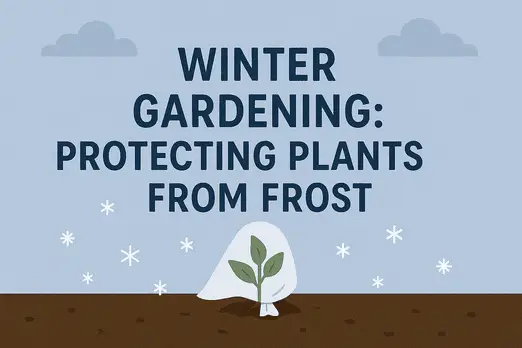Winter presents unique challenges for gardeners, as plummeting temperatures and frost can severely damage or even kill vulnerable plants. However, with careful planning and the implementation of appropriate protection methods, you can successfully nurture your garden through the cold months and enjoy a vibrant spring display. This comprehensive guide explores effective strategies for protecting your plants from frost and ensuring their survival throughout the winter.
JUMP TO TOPIC
Understanding Frost and its Impact on Plants
Frost occurs when the temperature of plant surfaces drops below freezing (0°C or 32°F), causing ice crystals to form within plant tissues. This ice formation disrupts cellular processes, leading to dehydration, cell rupture, and ultimately, plant death. The severity of frost damage depends on several factors, including the intensity and duration of the frost, the plant species’ hardiness, and the plant’s overall health. Young, actively growing plants are particularly susceptible to frost damage.
Different plants exhibit varying degrees of cold hardiness. Some are inherently frost-tolerant (hardy), while others are more sensitive (tender). Understanding your plants’ cold hardiness zones is crucial for selecting appropriate winter protection measures. This information is typically available from plant labels or reputable gardening resources.
Choosing Cold-Hardy Plants
The foundation of successful winter gardening lies in selecting plants that are well-suited to your climate’s winter conditions. Researching the hardiness zones in your area is paramount. Choose plants that are rated to withstand the lowest temperatures typically experienced in your region. Numerous resources, including online plant databases and local agricultural extension offices, can assist you in this process.
When selecting plants, consider their mature size and growth habits. Overcrowding can hinder air circulation, increasing the risk of frost damage. Ensure adequate spacing between plants to allow for proper ventilation.
Effective Frost Protection Methods
Several methods can effectively protect your plants from frost damage. The most appropriate method will depend on the severity of the frost, the type of plant, and the available resources.
1. Row Covers and Cloches:
Row covers, lightweight fabrics like fleece or agribon, are inexpensive and highly effective in providing a protective barrier against frost. They trap warmth radiating from the soil and reduce the impact of cold winds. Cloches, individual covers typically made of plastic or glass, offer similar protection for individual plants or small groups of plants. Ensure proper ventilation to prevent overheating during the day.
2. Cold Frames:
Cold frames provide a more substantial level of frost protection. They are essentially miniature greenhouses, typically consisting of a wooden or metal frame covered with glass or plastic. Cold frames are ideal for protecting more delicate plants or for extending the growing season into the colder months. They effectively moderate temperature fluctuations.
3. Mulching:
Applying a thick layer of mulch around the base of plants helps to insulate the soil and protect roots from freezing temperatures. Organic mulches, such as straw, shredded leaves, or wood chips, are excellent choices. Mulch helps retain soil moisture and moderates soil temperature fluctuations, reducing the risk of frost damage.
4. Water:
Watering plants thoroughly before a predicted frost can offer some protection. Water releases latent heat as it freezes, providing a small degree of insulation to plant tissues. However, this method is most effective in conjunction with other frost protection measures and is less effective with very severe frosts.
5. Relocating Plants:
For pot-grown plants, moving them to a sheltered location, such as a garage, shed, or unheated indoor space, can provide substantial frost protection. Ensure that the plants are not exposed to extreme temperature fluctuations within the sheltered location.
6. Microclimates:
Utilize the natural microclimates within your garden to your advantage. South-facing walls and sheltered areas generally experience milder temperatures than exposed locations. Position your more vulnerable plants in these protected microclimates.
7. Plant Supports:
Some plants, especially those with tender stems, may benefit from supporting structures to prevent damage from ice and snow. This is particularly important for plants that are prone to bending or breaking under the weight of frost or snow.
Post-Frost Care
Even with the best protection measures, some frost damage may still occur. After a frost event, carefully assess your plants for damage. Frost-damaged leaves may appear wilted, blackened, or translucent. Remove severely damaged leaves and stems to prevent the spread of disease.
Avoid pruning or fertilizing frost-damaged plants immediately after a frost. Allow the plants time to recover before undertaking any pruning or fertilizing activities. Watering may be necessary to help rehydrate plants that have experienced significant moisture loss due to frost.
Preventing Future Frost Damage
Careful planning and proactive measures can significantly minimize the risk of frost damage in future winters. This includes:
- Careful plant selection based on hardiness zones.
- Proper plant spacing to ensure adequate air circulation.
- Regular monitoring of weather forecasts to anticipate frost events.
- Implementation of appropriate frost protection methods.
- Regular maintenance to ensure healthy plant growth.
Conclusion
Winter gardening requires a proactive approach to protect plants from the damaging effects of frost. By understanding the mechanisms of frost damage, selecting appropriate plants, and implementing effective protection methods, gardeners can successfully nurture their gardens through the cold months and enjoy a thriving garden throughout the year. Regular monitoring, preventative measures, and post-frost care are essential components of successful winter gardening.

